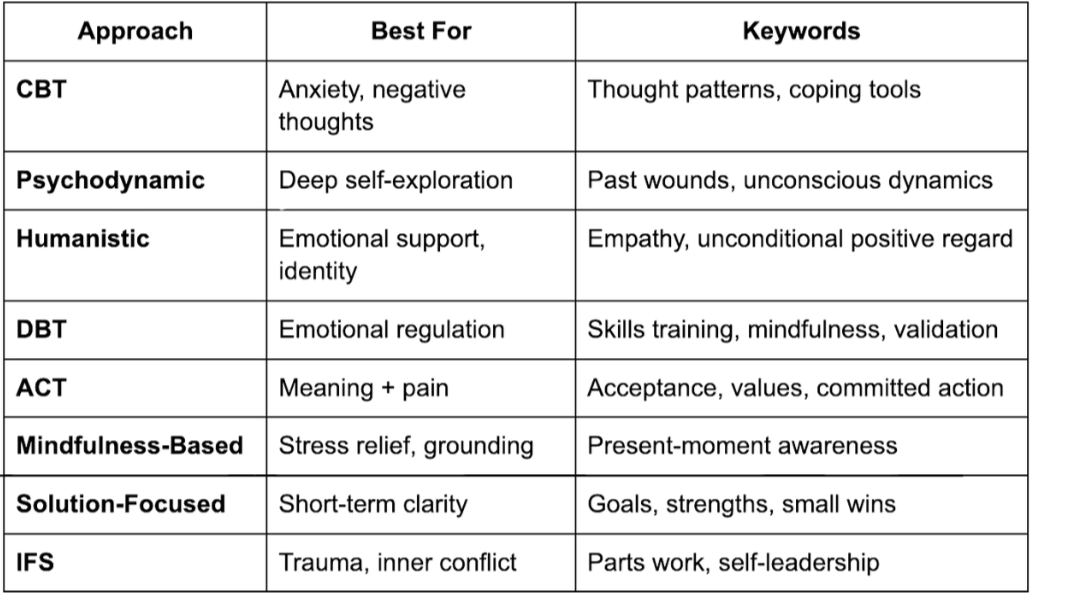8 Types of Therapy Compared: CBT, DBT, ACT, IFS & More Explained Simply
If you’ve ever Googled “types of therapy,” you probably ended up in a sea of acronyms. CBT. ACT. DBT. IFS. It can all feel a bit like alphabet soup, with your emotional well-being somewhere floating in the broth.
So let’s break it down. Below is a quick, clear guide to eight of the most popular therapy orientations in the U.S.: what they are, how they work, and who they tend to help most. No jargon, just honest summaries based on research and practice.
1. Cognitive Behavioral Therapy (CBT)
Best for: Anxiety, depression, OCD, phobias, panic attacks
How it works: CBT helps you identify unhelpful thoughts (“I’m a failure,” “This will never get better”) and shift the behaviors that reinforce them. It's structured, goal-oriented, and gives you practical tools you can use in real life. Think worksheets, coping strategies, and new ways of responding to old patterns.
Why it's popular: It’s one of the most researched therapies out there.
“What am I telling myself, and is that thought actually helping?”
2. Psychodynamic Therapy
Best for: Long-term patterns, trauma, relationship issues, self-understanding
How it works: Rooted in Freud (but far less couch and cigar), this approach explores how your past experiences, especially early relationships, shape how you feel, think, and relate today. It's less structured, more exploratory, and great if you want to go deep.
Why it’s still relevant: It helps people make sense of why they feel stuck, even when they know better.
“What’s under the surface of this reaction or dynamic?”
3. Humanistic / Person-Centered Therapy
Best for: Self-esteem, identity work, emotional healing, personal growth
How it works: At its core, this is therapy rooted in warmth, presence, and unconditional positive regard. You lead the session; the therapist reflects and holds space. Humanistic therapy assumes you already have what you need, it’s about clearing the noise.
Why people love it: It’s validating, non-directive, and deeply supportive.
“You get to be exactly who you are here, and that’s enough.”
4. Dialectical Behavior Therapy (DBT)
Best for: Emotion dysregulation, BPD, chronic suicidality, intense relationships
How it works: DBT blends mindfulness, emotion regulation, distress tolerance, and interpersonal effectiveness skills. Originally developed for borderline personality disorder, it’s now used for anyone who struggles to stay steady emotionally.
Often used in: Group therapy, hospital programs, skills training series.
“Two things can be true at once: I’m doing my best and I want to change.”
5. Acceptance and Commitment Therapy (ACT)
Best for: Depression, anxiety, chronic pain, existential stuckness
How it works: ACT teaches you to stop fighting uncomfortable feelings and start building a life aligned with your values. It's less about changing your thoughts and more about changing your relationship to them.
Big themes: Mindfulness, self-compassion, and doing what matters, even when it’s hard.
“You can carry pain and move toward something meaningful.”
6. Mindfulness-Based Therapies (MBCT, MBSR)
Best for: Stress, anxiety, relapse prevention, burnout
How it works: Mindfulness-based approaches teach you how to notice your thoughts without getting swept away by them. You learn to slow down, breathe, and observe rather than react. Often used in combination with CBT or ACT.
Bonus: You don’t need to be a meditator to benefit.
“What happens if I notice this moment, just as it is?”
7. Solution-Focused Brief Therapy (SFBT)
Best for: Coaching-style therapy, short-term goals, clarity around change
How it works: This approach focuses less on problems and more on what’s already working. You and your therapist collaborate to clarify goals and identify small, realistic next steps. It’s efficient and strengths-based.
Often used in: Schools, clinics, brief therapy settings, or during transitional life stages.
“When was this not a problem, and what were you doing differently?”
8. Internal Family Systems (IFS)
Best for: Trauma, complex emotions, inner conflict, self-compassion work
How it works: IFS assumes that we all have “parts” (like the anxious part, the angry part, the perfectionist). These parts aren’t bad, they’re trying to protect us. Therapy helps you unblend from these parts, get curious, and find the calm, compassionate “Self” underneath.
Why it’s powerful: It reframes internal conflict as something that can be healed, not banished.
“There’s a part of me that’s scared, and I can listen to it without letting it take over.”
So… Which One Is Right for Me?
Honestly? It depends. Many therapists (myself included) are integrative, meaning we borrow tools and frameworks from multiple approaches to fit your needs. Your goals, your history, and your nervous system all matter here.
Some folks thrive with a structured plan. Others need space to feel, explore, or reconnect to themselves. It’s not about which approach is “best”, it’s about which one meets you where you are.
TL;DR Comparison Table:
If you’re thinking of starting therapy (or switching approaches), this is something we can talk through together. You don’t have to know all the answers before you begin.
I’ve got the training, you bring the curiosity. We’ll figure it out.


